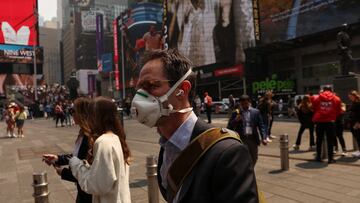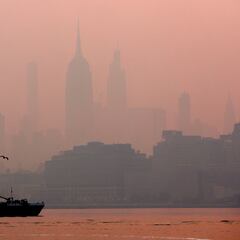Canadian wildfire smoke: Is it safe to work outside? This is what experts say
With air quality remaining in the unhealthy range, here is what the experts say employers should to to protect their workers.


Climate change as a political issue comes to the forefront of the discussion when its manifestations become impossible to ignore. This week has been one of those moments for New Yorkers, as smoke from an unprecedented number of wildfires burning in Canada burry the city in a cloud of smoke. With an Air Quality Index (AQI) of 160, New York City ranked third in the world for the most toxic air, behind Dhaka, Bangladesh and Lahore, Pakistan.
For reference, an AQI between zero and fifty is considered “healthy.” When the air becomes so polluted that it encroaches on unsafe territory, public health officials warn that sensitive groups such as children and the elderly limit the time they spend outside. But as AQI readers begin to push past 100, all people should begin to limit their exposure, and for those who work outdoors, this is particularly true.
You can track the smoke from the wildfires in real time.
New York issues a warning to protect workers
The New York Department of Labor announced that employers in “farming and agriculture, construction, landscaping, highway maintenance, and other fields that require outdoor heavy-exertion labor” should protect their employees without specifying what steps to be taken. The state’s governor Kathy Hochul said that N-95 masks should be worn outside and that strenuous activity should be avoided.
Air quality continues to be unhealthy in many areas of the state.
— Governor Kathy Hochul (@GovKathyHochul) June 8, 2023
Take steps to reduce negative health effects:
• Stay indoors
• Keep windows closed
• Avoid strenuous activities
If you must travel outdoors, high-quality masks help reduce exposure.
Stay safe, New York.
Related stories
For workers in the above-mentioned sectors, work is often strenuous, and the state has not made clear what employers should do to limit the risk to their staff. What the state has said is that if employees begin to present with symptoms that they have been overexposed to the smoke, employers must provide them with paid time off to rest and recover.
As the air quality health advisory continues, we urge all New Yorkers to stay safe and take precautions when working outside.@NYSDEC and @HealthNYGov are closely monitoring the air quality and sharing the most up-to-date information to help you protect your health. pic.twitter.com/i5aDg8VOJn
— NYS Department of Labor (@NYSLabor) June 7, 2023
Public health experts in California have released more detailed advice to employers, considering that the state has been wracked by such terrible forest fires that have disrupted daily life in recent years. The guidance was designed for days or weeks where the AQI does not fall below 151. Where applicable, employers should reduce exposure by “providing enclosed structures or vehicles for employees to work in where the air is filtered.” In addition to handing out respirators, employers should try to adjust the schedules of their staff and move them to areas where the smoke is not as intense.

